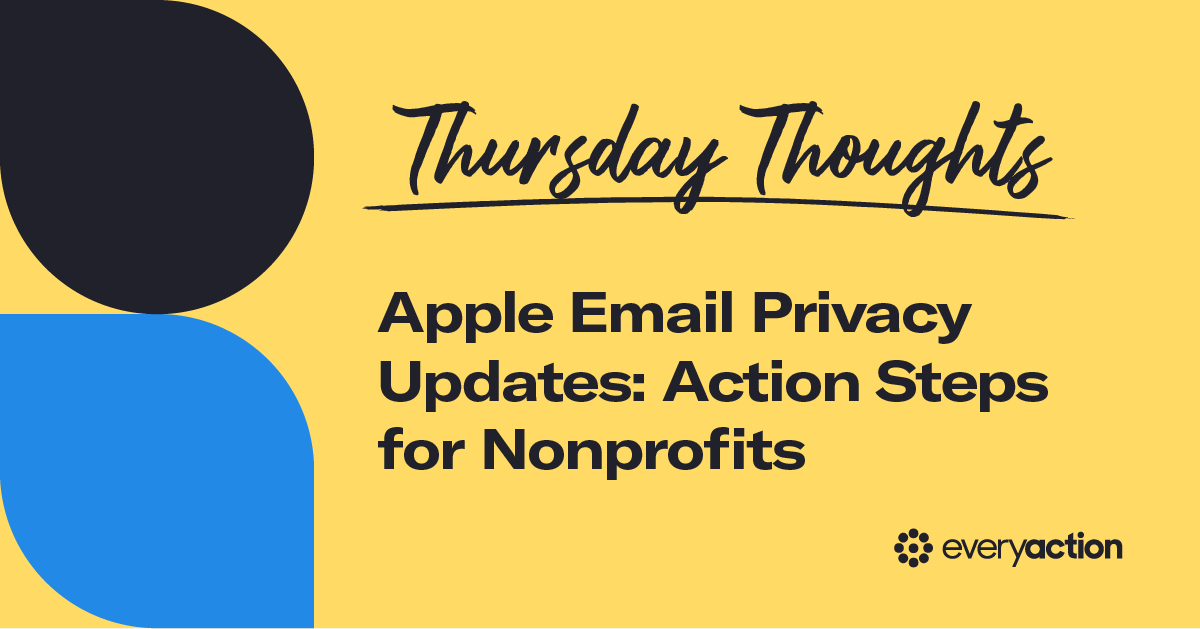Thursday Thoughts | Apple Email Privacy Updates: Action Steps for Nonprofits

Welcome to another installment of Thursday Thoughts, a dedicated space for our friends in nonprofit sector leadership to reflect on reports, statistics, and other trends—because when our community shares knowledge, we can all do more good. Check out last month’s post here.
In case you missed it, Apple’s email privacy policy updates have email marketers everywhere re-evaluating their strategy—and that includes email professionals in the nonprofit sector. Here’s how our friend Tammy Gilbert Cardona at Nonprofit Software Specialists sets the scene:
At its Worldwide Developer Conference (WWDC) held in June, Apple announced new privacy protection features that will appear in the fall iOS 15 update. The new feature in the Mail app, known as Mail Privacy Protection, can stop email senders from knowing when a user has opened an email, and it masks the user’s IP address so the address can’t be linked to other online activity or be used to determine the user’s location.
Our friends at Data Axle, a predictive marketing and data agency, and Nonprofit Software Specialists, a nonprofit technology agency, shared their thoughts on Apple’s email privacy policy, including recommendations for action steps nonprofits should take now to prepare.
Data Axle
Here’s what Thom Porter from Data Axle’s Inboxable team had to say about the Apple email privacy update:
“Apple’s announcement has created uncertainty regarding traditional email KPIs, but there is hope[…] Email has always proven its ability to adapt and evolve. We know the open rate won’t go away entirely (at least not yet), given it’s the only metric available today that allows senders to measure the initial level of interest a subscriber has with content before the click. Even so, marketers should not be relying solely on the metric of open rates. A 360 degree view of email performance, including both deliverability and engagement, is now integral to truly understanding subscribers and program success.”
The most important takeaway? “We need to start measuring our efforts in new ways,” says Porter. Data Axle lists six action steps organizations should take now to be prepared for the big privacy shift:
- Gather more first party data—that’s “info a marketer collects at the point of sign-up for each subscriber,” which means organizations can better cater to each individual’s preferences.
- Focus on consent—i.e., follow clear and concise opt-in practices. Ultimately, “doing this will ensure you’re only communicating with those subscribers who really want to hear from you.”
- Give users control by implementing preference centers. Your organization should “make it easy for recipients to scale back [on messages they receive] or to unsubscribe altogether.”
- Segment your mail stream. Data Axle calls this practice “vital to understanding your audience,” and we agree: segmenting your email audiences and targeting each audience with appropriate messaging means your nonprofit can send the right messages, to the right supporters, at the right time.
- Find new ways to adapt and engage with your audience. “Give your list a reason to click” with personalized, supporter-specific messages.
- Improve deliverability. Data Axle estimates that roughly 20% of emails don’t reach client inboxes, so investing in deliverability tools and practices that don’t rely solely on opens and pixel-tracking can help your organization reach your email goals.
Nonprofit Software Specialists
Tammy Gilbert Cardona, Director of Business Development at Nonprofit Software Specialists, recommends nonprofits re-evaluate their content strategy in response to the Apple email privacy updates:
This new feature has the ability to change email marketing as we know it. What this means for your nonprofit is that donor engagement can no longer be gauged by click rates, a longtime benchmark in email marketing. Nonprofits will need to reestablish what defines a successful email campaign.
But don’t panic just yet. Remember, the goal in nonprofit email marketing is not just for your constituents to read the messaging, but to be moved to action. This is where true donor engagement comes into play. The question we now ask is, “How can a nonprofit organization determine if a campaign truly speaks to their donors & supporters?”
Well thought out content is the key to overcoming this new challenge. Now more than ever, your email campaigns must be compelling, timely, and personal. If your primary mode of communication with supporters has been e-newsletters, now may be the time to incorporate questions and calls to action within your communications, or embed video from other social media channels that track views. Ask yourself, when is the last time you have conducted email subject line optimization on your messaging? Or perhaps before the fall iOS update, your team may want to analyze the best days and times to send emails to your donors.
Ultimately, Porter and Cardona agree: this is a big moment for email. “This is an exciting time to be in email marketing,” says Porter. “Change is inevitable,” adds Cardona, “but thankfully the privacy changes that are on the horizon can be navigated and overcome by changing your email marketing metrics and by continuing to engage with your constituents in new and intriguing ways.”
Adapting in response to email privacy-related changes is a skill that won’t go away anytime soon, so nonprofits shouldn’t wait to update their practices—evolving your strategy now can help your organization’s messaging reach your intended audiences and make a deeper impact with your mission.


